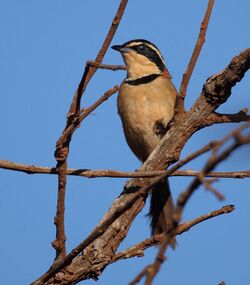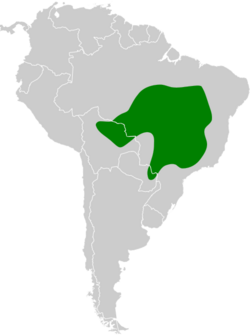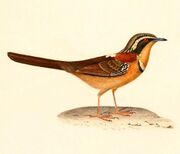Biology:Collared crescentchest
| Collared crescentchest | |
|---|---|

| |
| at Chapada dos Guimarães, Mato Grosso State, Brazil | |
| Scientific classification | |
| Domain: | Eukaryota |
| Kingdom: | Animalia |
| Phylum: | Chordata |
| Class: | Aves |
| Order: | Passeriformes |
| Family: | Melanopareiidae |
| Genus: | Melanopareia |
| Species: | M. torquata
|
| Binomial name | |
| Melanopareia torquata (Wied, 1831)
| |

| |
The collared crescentchest (Melanopareia torquata) is a species of bird in the family Melanopareiidae. It is found in Brazil and Paraguay.[1]
Taxonomy and systematics
The crescentchests (genus Melanopareia) were previously included in family Rhinocryptidae, the tapaculos. A 2010 publication confirmed earlier work and created their present genus.[2][3] The International Ornithological Congress (IOC) recognizes two subspecies of the collared crescentchest, the nominate Melanopareia torquata torquata and M. t. rufescens.[1] The South American Classification Committee of the American Ornithological Society (AOS) and the Clements taxonomy consider the double-collared crescentchest (M. bitoquata) to be a third subspecies.[2][4]
Description
The collared crescentchest is 14.5 cm (5.7 in) long. Two unsexed specimens of M. t. rufescens weighed 16.5 and 18.0 g (0.58 and 0.63 oz). The nominate subspecies' back and rump are brown and the underparts buff. The crown of the head is gray brown. It has a narrow white supercilium edged with black, a rufous "collar" on the back of the neck, and a black band across the breast. Subspecies M. t. rufescens is almost identical but its crown is reddish brown.[5]
Distribution and habitat
The collared crescentchest is found primarily in central Brazil but also occurs in far northeastern Paraguay. It inhabits cerrado, a biome characterized by a mix of savannah and woodlands. It prefers wetter open areas and avoids disturbed areas. In elevation it ranges up to 1,400 m (4,600 ft).[5]
Behavior
Feeding
The collared crescentchest's diet has not been described but the species is assumed to be insectivorous.[5]
Breeding
Little is known about the collared crescentchest's breeding phenology. Its nest is a globe of dry grass and leaves placed near the ground. Two eggs are laid and both sexes incubate them and care for nestlings.[5]
Vocalization
Both sexes of collared crescentchest sing year round, usually from atop a low shrub. The song is "a series of 3-6 loud, resonant 'chip' notes" [1]. Its call is "a penetrating churr" [2].[5]
Status
The IUCN has assessed the collared crescentchest as being of Least Concern.[6] "Despite widespread degradation of cerrado habitat, the population of Collared Crescentchest is believed to be relatively stable throughout its large range."[5]
References
- ↑ 1.0 1.1 Gill, F.; Donsker, D.; Rasmussen, P. (January 2021). "IOC World Bird List (v 11.1)". https://www.worldbirdnames.org/.
- ↑ 2.0 2.1 Remsen, J. V., Jr., J. I. Areta, E. Bonaccorso, S. Claramunt, A. Jaramillo, D. F. Lane, J. F. Pacheco, M. B. Robbins, F. G. Stiles, and K. J. Zimmer. Version 19 January 2021. A classification of the bird species of South America. American Ornithological Society. https://www.museum.lsu.edu/~Remsen/SACCBaseline.htm retrieved January 19, 2021
- ↑ Ericson, P.G.P.; Olson, S.L.; Irestedt, M.; Alvarenga, H.; Fjeldså, J. (2010). "Circumscription of a monophyletic family for the tapaculos (Aves: Rhinocryptidae): Psiloramphus [sic] in and Melanopareia out". Journal of Ornithology 151: 337–345.
- ↑ Clements, J. F., T. S. Schulenberg, M. J. Iliff, S. M. Billerman, T. A. Fredericks, B. L. Sullivan, and C. L. Wood. 2019. The eBird/Clements Checklist of Birds of the World: v2019. Downloaded from http://www.birds.cornell.edu/clementschecklist/download/ Retrieved August 15, 2019
- ↑ 5.0 5.1 5.2 5.3 5.4 5.5 Drucker, J. (2020). Collared Crescentchest (Melanopareia torquata), version 1.0. In Birds of the World (T. S. Schulenberg, Editor). Cornell Lab of Ornithology, Ithaca, NY, USA. https://doi.org/10.2173/bow.colcre1.01 retrieved May 3, 2021
- ↑ Cite error: Invalid
<ref>tag; no text was provided for refs namedIUCN
Wikidata ☰ Q1261563 entry
 |



